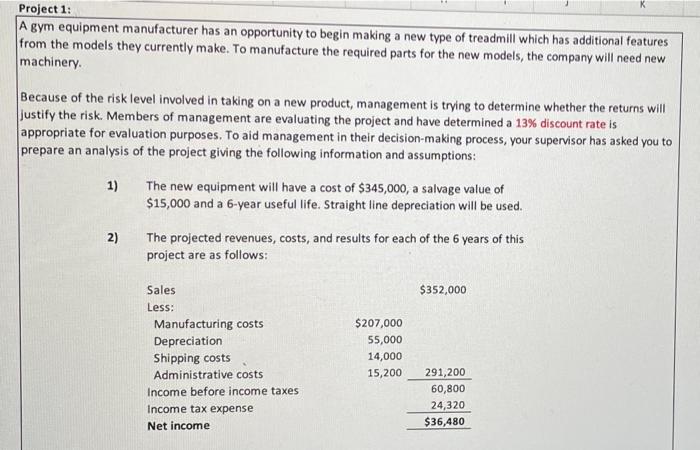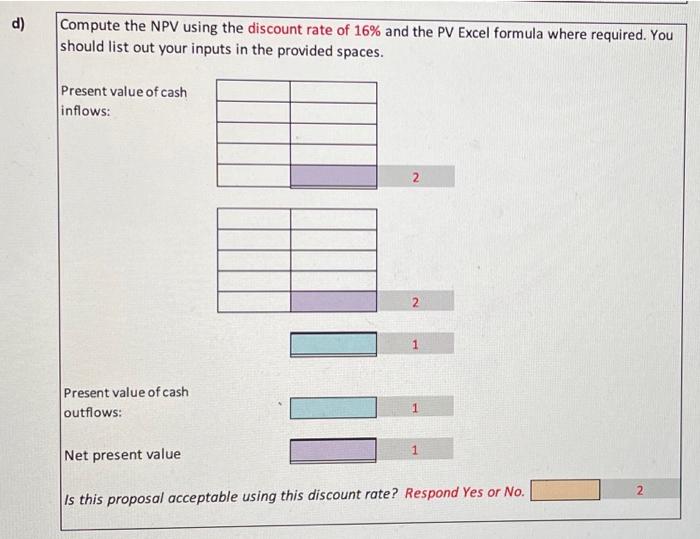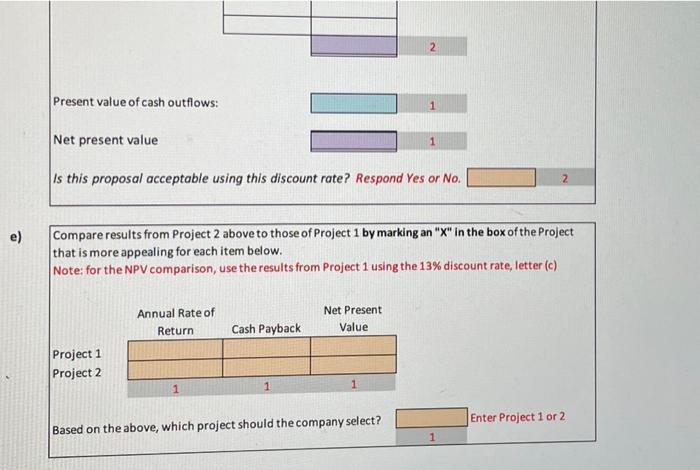Project 1: A gym equipment manufacturer has an opportunity to begin making a new type of treadmill which has additional features from the models they currently make. To manufacture the required parts for the new models, the company will need new machinery Because of the risk level involved in taking on a new product, management is trying to determine whether the returns will justify the risk. Members of management are evaluating the project and have determined a 13% discount rate is appropriate for evaluation purposes. To aid management in their decision-making process, your supervisor has asked you to prepare an analysis of the project giving the following information and assumptions: 1) The new equipment will have a cost of $345,000, a salvage value of $15,000 and a 6-year useful life. Straight line depreciation will be used. 2) The projected revenues, costs, and results for each of the 6 years of this project are as follows: $352,000 Sales Less: Manufacturing costs Depreciation Shipping costs Administrative costs Income before income taxes Income tax expense Net income $207,000 55,000 14,000 15,200 291,200 60,800 24,320 $36,480 a) Compute the annual rate of return. 2 b) Compute the payback period. Note that you will need to arrive at the net annual cash flow FIRST. 1 1 c) Compute the NPV using the discount rate of 13% and the PV Excel formula. You should list out your inputs in the provided spaces. Present value of cash inflows: 2 2 c) Compute the NPV using the discount rate of 13% and the PV Excel formula. You should list out your inputs in the provided spaces. Present value of cash inflows: 2 2 Present value of cash outflows: IDIO 1 1 Net present value 2 Is this proposal acceptable using this discount rate? Respond Yes or No. d) Compute the NPV using the discount rate of 16% and the PV Excel formula where required. You should list out your inputs in the provided spaces. Present value of cash inflows: 2 1 Il Present value of cash outflows: Net present value 2 Is this proposal acceptable using this discount rate? Respond Yes or No. The same gym equipment manufacturer has another opportunity presented to expand their current factory space to increase production and ultimately be able to reach new markets with their expanded manufacturing capacity. The company has determined the following information and assumptions for this new expansion idea: 1) The capital investment for this project will cost the company $485,000. Depreciation will be calculated over a 5 year life with no salvage value. 2) The projected annual net income for each of the five years are as follows: Year 1: Year 2: Year 3: Year 4: Year 5: Total 15,000 19,000 25,000 50,000 60,000 169,000 Instructions: Using the template below, a) compute the annual rate of return. b) prepare a table of the net annual cash flow and cumulative net cash flow. ) compute the payback period. d) compute the NPV using the determined 13% discount rate. Should the proposable be accepted using this discount rate? e) compare the results from Project 1 to determine which project is more appealing. eece e) a) Compute the annual rate of return b) Prepare a table of the net annual cash flow and cumulative net cash flow. (Hint: Don't forget about depreciation's impact on cash flow. Refer to M10 Excel Example!) Net Annual Cash Flow Cumulative Net Cash Flow Year 2 c) Compute the payback period. (Again, refer to M10 Excel Example!) Compute the payback period. (Again, refer to M10 Excel Examplel) 2 d) Compute the NPV using the discount rate of 13% and the NPV Excel formula. You should list out your inputs in the provided spaces. Present value of cash inflows: 2 1 Present value of cash outflows: 1 Net present value 2 Present value of cash outflows: 1 Net present value 1 Is this proposal acceptable using this discount rate? Respond Yes or No. 2 e) Compare results from Project 2 above to those of Project 1 by marking an "X" in the box of the Project that is more appealing for each item below. Note: for the NPV comparison, use the results from Project 1 using the 13% discount rate, letter (c) Annual Rate of Return Net Present Value Cash Payback Project 1 Project 2 1 1 Enter Project 1 or 2 Based on the above, which project should the company select














